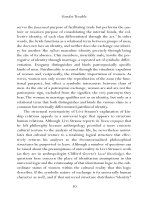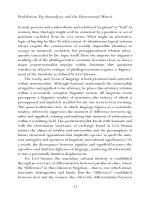GENDER TROUBLE 150
Bạn đang xem bản rút gọn của tài liệu. Xem và tải ngay bản đầy đủ của tài liệu tại đây (20.69 KB, 1 trang )
Subversive Bodily Acts
ating field of cultural possibilities. But instead, she prescribes a return
to a principle of maternal heterogeneity which proves to be a closed
concept, indeed, a heterogeneity confined by a teleology both unilinear
and univocal.
Kristeva understands the desire to give birth as a species-desire,
part of a collective and archaic female libidinal drive that constitutes
an ever-recurring metaphysical reality. Here Kristeva reifies maternity
and then promotes this reification as the disruptive potential of the
semiotic. As a result, the paternal law, understood as the ground of
univocal signification, is displaced by an equally univocal signifier, the
principle of the maternal body which remains self-identical in its teleology regardless of its “multiplicitous” manifestations.
Insofar as Kristeva conceptualizes this maternal instinct as having
an ontological status prior to the paternal law, she fails to consider the
way in which that very law might well be the cause of the very desire it
is said to repress. Rather than the manifestation of a prepaternal causality, these desires might attest to maternity as a social practice required
and recapitulated by the exigencies of kinship. Kristeva accepts LéviStrauss’s analysis of the exchange of women as prerequisite for the
consolidation of kinship bonds. She understands this exchange, however, as the cultural moment in which the maternal body is repressed,
rather than as a mechanism for the compulsory cultural construction
of the female body as a maternal body. Indeed, we might understand
the exchange of women as imposing a compulsory obligation on
women’s bodies to reproduce. According to Gayle Rubin’s reading of
Lévi-Strauss, kinship effects a “sculpting of . . . sexuality” such that the
desire to give birth is the result of social practices which require and
produce such desires in order to effect their reproductive ends.14
What grounds, then, does Kristeva have for imputing a maternal
teleology to the female body prior to its emergence into culture?
To pose the question in this way is already to question the distinction
between the Symbolic and the semiotic on which her conception of
the maternal body is premised. The maternal body in its originary
115









